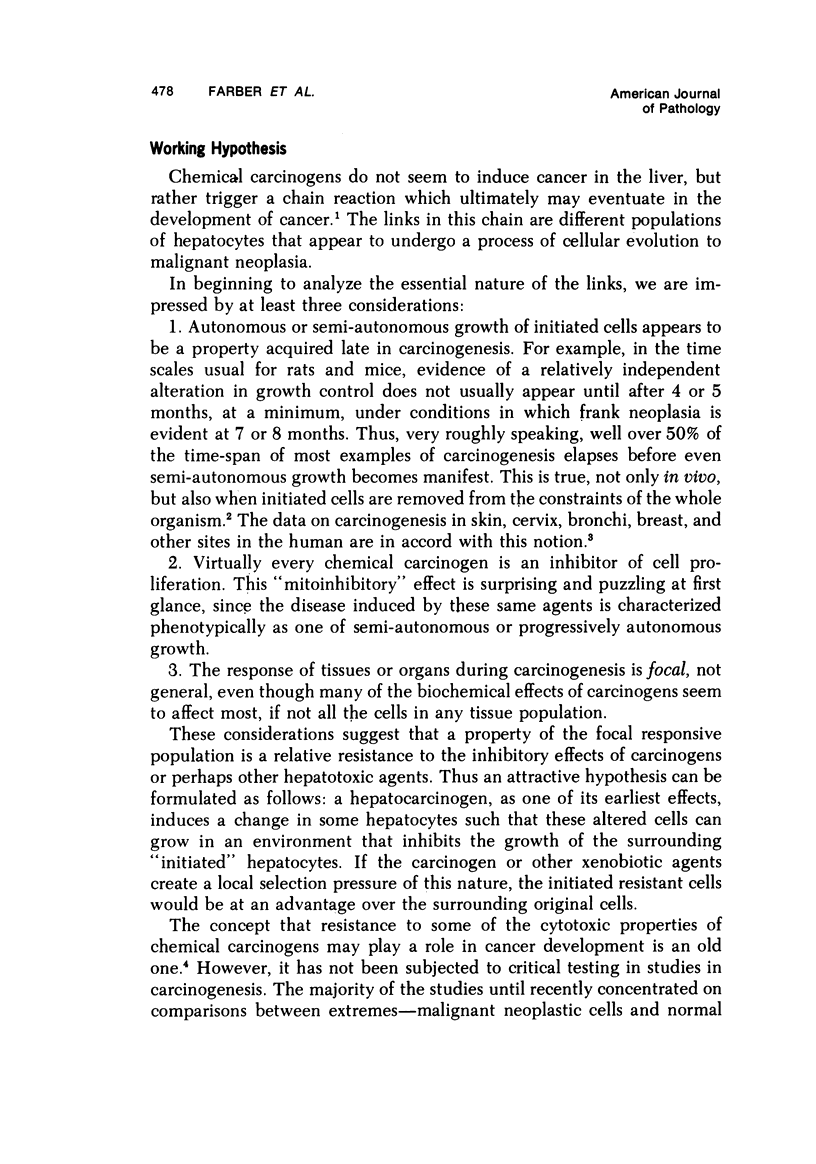Abstract
A new hypothesis leading to a new model of liver carcinogenesis is described; it is based on the acquisition by carcinogen-altered hepatocytes during initiation of a new functional handle--resistance to the cytotoxicity of a carcinogen--and on the ability of such cells to proliferate in an environment that prevents proliferation of normal hepatocytes. The creation of such a differential environment now enables a quantitative analysis for initiation, the beginning synchronization of the putative premalignant hepatocytes for about 15 cell cycles, the study of the pattern of growth of such resistant cells to form nodules that have some resemblance to the organizational pattern of fetal liver, the analysis of the appearance of distinctive positive and negative markers for these cells, and the further investigation of the development of liver cancer from such cells. The remarkable similarity in overall pattern betweeen the development of cancer in the skin and in the liver with chemicals and the possible role of both somatic mutation and neodifferentiation in carcinogenesis are briefly discussed.
Full text
PDF





Selected References
These references are in PubMed. This may not be the complete list of references from this article.
- Becker F. F., Klein K. M. The effect of L-asparaginase on mitotic activity during N-2-fluorenylacetamide hepatocarcinogenesis: subpopulations of nodular cells. Cancer Res. 1971 Feb;31(2):169–173. [PubMed] [Google Scholar]
- Cameron R., Sweeney G. D., Jones K., Lee G., Farber E. A relative deficiency of cytochrome P-450 and aryl hydrocarbon [benzo(a)pyrene] hydroxylase in hyperplastic nodules induced by 2-acetylaminofluorene in rat liver. Cancer Res. 1976 Nov;36(11 Pt 1):3888–3893. [PubMed] [Google Scholar]
- Farber E. Carcinogenesis--cellular evolution as a unifying thread: Presidential address. Cancer Res. 1973 Nov;33(11):2537–2550. [PubMed] [Google Scholar]
- Farber E., Parker S., Gruenstein M. The resistance of putative premalignant liver cell populations, hyperplastic nodules, to the acute cytotoxic effects of some hepatocarcinogens. Cancer Res. 1976 Nov;36(11 Pt 1):3879–3887. [PubMed] [Google Scholar]
- Gravela E., Feo F., Canuto R. A., Garcea R., Gabriel L. Functional and structural alterations of liver ergastoplasmic membranes during DL-ethionine hepatocarcinogenesis. Cancer Res. 1975 Nov;35(11 Pt 1):3041–3047. [PubMed] [Google Scholar]
- Kitagawa T. Responsiveness of hyperplastic lesions and hepatomas to partial hepatectomy. Gan. 1971 Jun;62(3):217–224. [PubMed] [Google Scholar]
- LAWS J. O. Tissue regeneration and tumour development. Br J Cancer. 1959 Dec;13:669–674. doi: 10.1038/bjc.1959.74. [DOI] [PMC free article] [PubMed] [Google Scholar]
- Laerum O. D., Rajewsky M. F. Neoplastic transformation of fetal rat brain cells in culture after exposure to ethylnitrosourea in vivo. J Natl Cancer Inst. 1975 Nov;55(5):1177–1187. doi: 10.1093/jnci/55.5.1177. [DOI] [PubMed] [Google Scholar]
- Okita K., Noda K., Fukumoto Y., Takemoto T. Cytochrome P-450 in hyperplastic liver nodules during hepatocarcinogenesis with N-2-fluorenylacetamide in rats. Gan. 1976 Dec;67(6):899–902. [PubMed] [Google Scholar]
- Solt D. B., Medline A., Farber E. Rapid emergence of carcinogen-induced hyperplastic lesions in a new model for the sequential analysis of liver carcinogenesis. Am J Pathol. 1977 Sep;88(3):595–618. [PMC free article] [PubMed] [Google Scholar]


